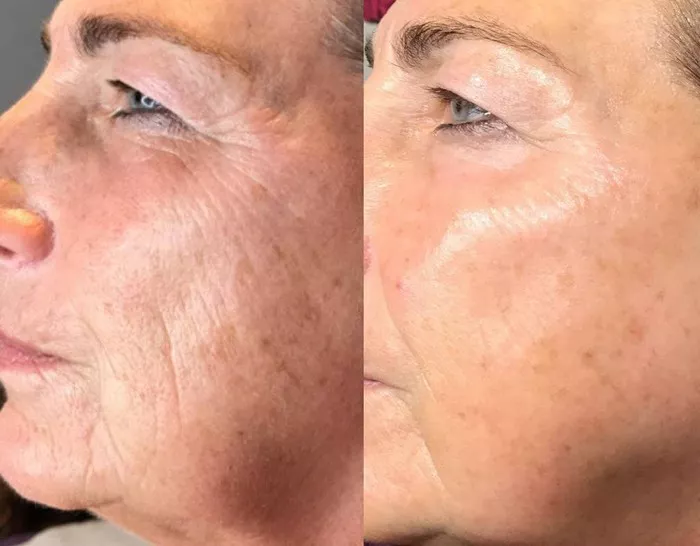Wrinkles are a common concern for many individuals as they age. If you’re looking for an effective treatment to reduce the appearance of wrinkles, laser therapy can be a viable option. Laser treatments use targeted energy to stimulate collagen production, improve skin texture, and minimize wrinkles. However, with several laser options available, it’s important to understand which laser is best suited for wrinkle reduction. In this article, we will explore different types of lasers commonly used for treating wrinkles and provide insights into their effectiveness.
Understanding Wrinkles and Laser Therapy
Wrinkles are a result of various factors, including age, sun exposure, genetics, and lifestyle choices. Over time, the skin loses its elasticity and collagen, leading to the formation of lines and creases. Laser therapy is a non-surgical approach that can address wrinkles by targeting the underlying causes and promoting skin rejuvenation.
Laser treatments work by delivering controlled beams of light energy into the skin. The energy is absorbed by the targeted tissues, stimulating collagen production and triggering the body’s natural healing response. As collagen levels increase, the skin becomes firmer, smoother, and more youthful in appearance.
Different Types of Lasers for Wrinkle Reduction
There are several types of lasers commonly used for wrinkle reduction. Each laser operates at a specific wavelength and penetrates the skin to different depths, targeting specific concerns. Let’s explore some of the popular laser options:
-
Fractional Laser Resurfacing
Fractional laser resurfacing is a popular choice for treating wrinkles. This treatment uses a laser beam that is fractionated into thousands of microscopic columns. These columns of energy create controlled injuries in the skin, stimulating collagen production and promoting skin rejuvenation. Fractional lasers can be ablative or non-ablative. Ablative lasers remove thin layers of skin, while non-ablative lasers deliver energy without damaging the outer layer. Fractional laser resurfacing is effective for reducing the appearance of both fine lines and deeper wrinkles.
-
Carbon Dioxide (CO2) Lasers
CO2 lasers are ablative lasers that vaporize the outer layers of the skin. These lasers emit a high-intensity beam of light that precisely removes damaged skin cells and stimulates collagen production. CO2 lasers are particularly effective for treating deeper wrinkles and more severe signs of aging. However, the recovery time can be longer compared to other laser treatments.
-
Erbium Lasers
Erbium lasers are another ablative option for wrinkle reduction. These lasers deliver high-energy light that is absorbed by water molecules in the skin, causing controlled damage to the targeted areas. Erbium lasers are commonly used for treating superficial and moderately deep wrinkles. They provide effective results with a shorter recovery period compared to CO2 lasers.
-
Non-Ablative Lasers
Non-ablative lasers, such as Nd:YAG and pulsed dye lasers, work by heating the deeper layers of the skin without damaging the surface. These lasers stimulate collagen production and improve skin texture, reducing the appearance of wrinkles. Non-ablative lasers have minimal downtime and are well-suited for individuals with milder wrinkles or those seeking a less invasive treatment option.
-
Intense Pulsed Light (IPL)
IPL devices use a broad spectrum of light wavelengths to target various skin concerns, including wrinkles. IPL can improve skin tone, reduce redness, and minimize the appearance of fine lines. While IPL is not a laser, it is often categorized under laser treatments due to its similar light-based technology.
Choosing the Best Laser for Your Needs
The best laser for wrinkles depends on several factors, including the severity of wrinkles, skin type, desired results, and individual considerations. It’s crucial to consult with a qualified dermatologist or laser specialist who can assess your skin and recommend the most appropriate laser treatment for your specific needs.
During the consultation, the professional will evaluate your skin condition, discuss your treatment goals, and determine the most suitable laser option. They may recommend a single type of laser or a combination approach tailored to address your unique concerns effectively.
Considerations and Expectations
When considering laser treatment for wrinkles, it’s important to have realistic expectations. While lasers can significantly improve the appearance of wrinkles, they may not completely eliminate them, particularly deep lines or severe signs of aging. The effectiveness of laser treatments can vary depending on factors such as the depth of wrinkles, skin condition, and individual response to treatment. Multiple sessions may be required to achieve optimal results.
Additionally, laser treatments may involve a recovery period, ranging from a few days to a couple of weeks, depending on the type of laser used. During this time, the skin may appear red, swollen, or sensitive. It’s important to follow post-treatment care instructions provided by your healthcare provider to ensure proper healing and minimize any potential side effects.
Conclusion
Laser therapy is an effective non-surgical option for reducing the appearance of wrinkles. The choice of laser depends on the specific needs of the individual, including the type and severity of wrinkles. Fractional laser resurfacing, CO2 lasers, erbium lasers, non-ablative lasers, and IPL are among the common laser options used for wrinkle reduction. Consulting with a qualified professional is crucial to determine the most suitable laser treatment and to develop a personalized treatment plan that aligns with your goals and expectations. With the right laser and professional guidance, you can achieve smoother, rejuvenated skin and a more youthful appearance.

